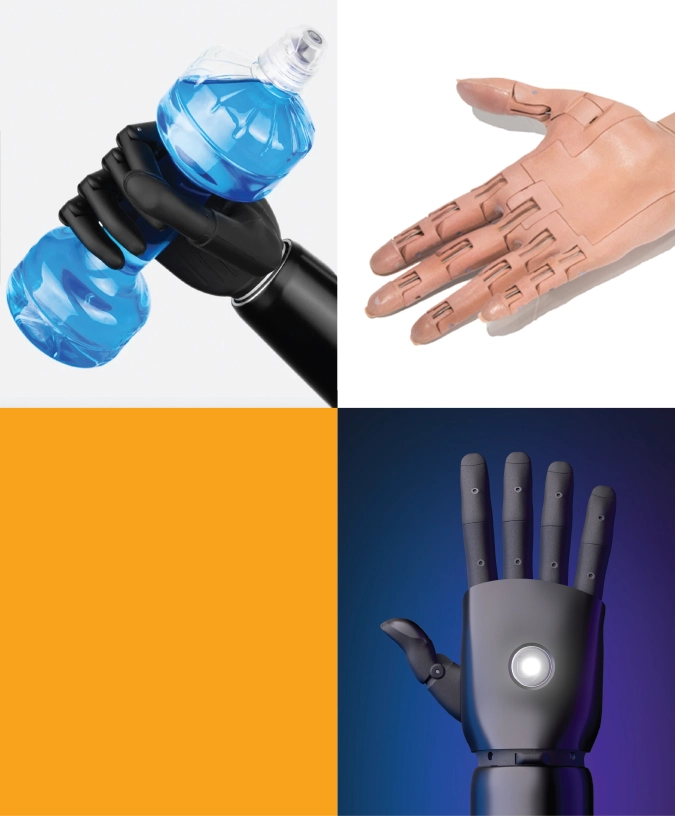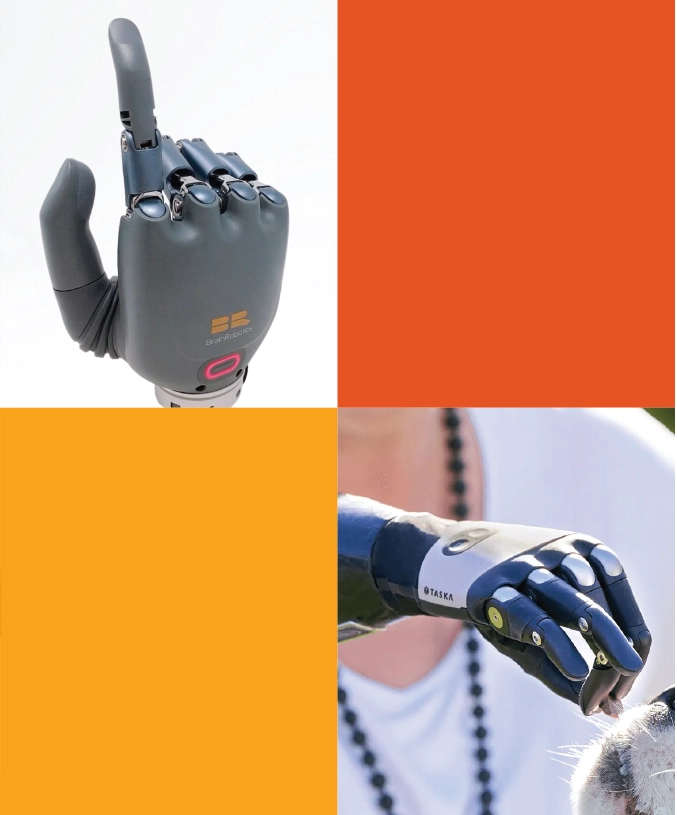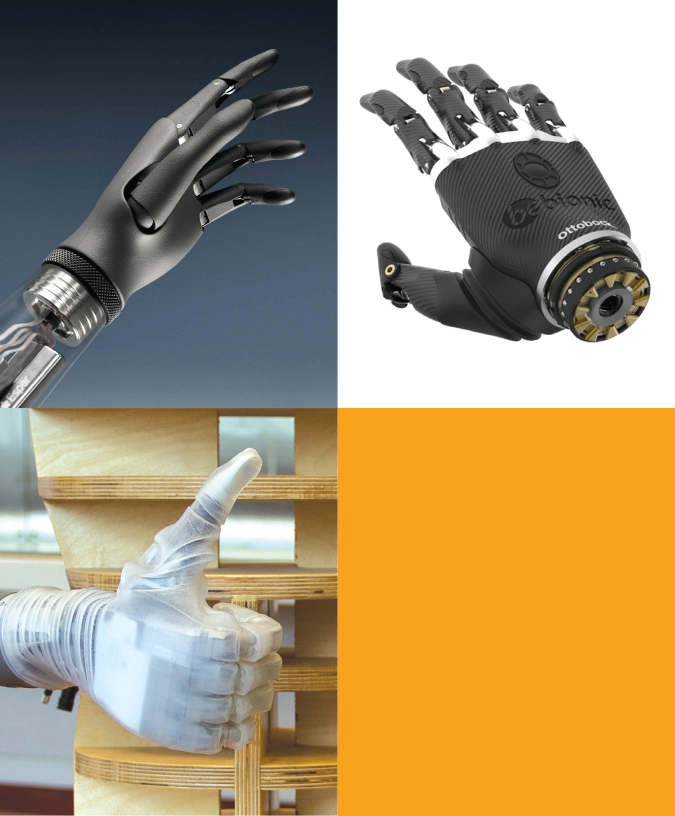Next-gen bionic arms and hands offer mind-blowing technological sophistication. But choosing the right device can blow your mind, too—and not in a good way.
By Chloé Valentine Toscano

Chloé Valentine Toscano.
Courtesy Chloé Valentine Toscano.
After becoming a transhumeral amputee, I naively assumed someone would take a cast of my limb and fit me with the most awesome bionic superhero arm in the world, complete with every decoration of my choice. But when I showed up at my prosthetist’s office, my clinician presented me with only one hand as an option, and it didn’t come close to what I wanted or needed.
Through some personal research, I discovered that there’s a vast assortment of offerings and innovations out there. But then I felt overwhelmed by the massive selection of devices, each of them accompanied by a laundry list of tech specs, extravagant claims of “groundbreaking” technology and benefits, and (in many cases) media coverage that’s long on hype but short on specifics. It’s not always clear which products are available now and which are still in the experimental, pre-market stage. This isn’t a situation where you can throw a bionic device into your online cart, have it delivered to your doorstep, attach it to your socket, and start wiggling fingers and flipping off your mean neighbor.
I’d rather have too many choices than not be given any choices at all, as was my case. But it’s good to know what the options are and what each can (and can’t) do. My goal here is to equip upper-extremity amputees with some tools to make sense of a chaotic marketplace, advocate for themselves, understand where to look for information, and consider all the relevant factors before settling on anything.

Questions to Ask Yourself
During Heather Rodriguez’s first appointment with her prosthetist, she was told she’d be receiving a bebionic myoelectric arm from Ottobock. “It was his first time working with it,” says Rodriguez, who lost her left arm in a car accident. “It was just that hand, and they didn’t bring any other brands up.” Rodriguez was never given the ability to evaluate other components of her system, such as the harness or socket. “I’m now finding out about more brands through Instagram and by talking to other amputees,” she says, “and I’m asking myself where all this information was when I was trying to pick out my arm.”
Just because your prosthetist is trained to deliver a prosthesis, it doesn’t mean they have a holistic view of the marketplace. They might recommend a device they’re familiar with, but that doesn’t mean it will necessarily be right for you. Before you accept any recommendation, there are questions you should ask to make sure you’re getting a device that’s compatible with your needs. Asking questions will not only help you learn what’s available but also will help you communicate your goals and priorities to your clinician.
To begin with, ask yourself: What are my function goals? Take a beat to think of your day-to-day. What are the things you do most often? Which tasks slow you down the most? What specific activities are you looking to improve with the use of a myo? Maybe there’s a single thing you want it for and nothing else. In that case, you want to understand which device(s) will best allow you to enjoy that activity, versus springing for the fanciest, most complex, and priciest device. Because that won’t necessarily be the limb to get you there.

“A Hero Arm is beautiful, but beyond holding a bag it doesn’t perform [many functions],” says Dayna Troisi, an executive editor at GO Magazine and a former iLimb and bebionic user. “The bebionic was very sturdy—I wore it while working at a wine bar and even at the gym.”
Another key question to ask is whether a bionic device will truly benefit you, or whether it will just slow you down. Every prosthesis costs a certain amount of time, attention, and effort. Do the benefits justify those investments? I’m hyper-efficient without the use of any prosthesis and can get through my day very effectively. So I opted out of using a weighty prosthesis that I thought would hold me back rather than expanding my freedom.
For me, one of the most relevant questions was: How do I want my bionic arm to look? As a creative and an artist, I tend to lead with aesthetics, so that’s where I dove in when it came time to decide what I wanted. Having a prosthesis that looked realistic wasn’t a priority for me. I wanted to lean into my eclectic side and have something sparkly and otherworldly. Some clinicians will wave aside the discussion on the look, wanting to focus on the function, but the appearance is just as important. How your prosthesis looks will impact your ability to accept the device as an extension of yourself.
“I don’t use my arm, because I can’t wear any tops without [the harness] showing,” Rodriguez says. “The hand itself is cool—it’s just [simple] black carbon fiber.” But she feels the overall device is bulky and doesn’t look good on her. If you stop using a device because you don’t like the way it looks, it doesn’t matter how affordable or functional it might be. So it’s important to envision how you want your prosthesis to look before you make a choice. If you want something sleek and as close to human as possible, and your prosthetist touts the Hero Arm—which looks like something out of a Marvel superhero movie—you’d only be setting yourself up for frustration. Insist on a tool that matches your mental image and can be molded to achieve the look you have in mind.
Questions to Ask Your Prosthetist
The first question to ask your clinician is: “Based on my goals for aesthetics and function, what bionic hand(s) would you recommend?” You want to come away with a narrowed-down set of options so you can thoroughly research a targeted number of products instead of sifting through every bionic device that’s out there. But I’d urge you not to settle for just one recommendation from your prosthetist. Some clinics and/or practitioners will lean toward one manufacturer or another, and you don’t want your choice to come down to whatever device they know best (or whichever one makes them the most money).

A related question is what type of socket system you’ll be using to control each device. “For some people, the newer pattern-recognition technology may be easier to adapt to, versus using a two-site system,” explains Dez Joseph, CPO , a certified prosthetist for Brooklyn-based Orthocraft. “A two-site system relies on two different muscles to control the hand and wrist rotator if one is added. A pattern-recognition system will use an array of electrodes to control the device using more natural movements the control the hand. The benefit of pattern recognition is that you use less energy to send signals.” Both options have their pros and cons. Whichever one your prosthetist recommends, ask them why that’s the best option for you, and have them explain what that will entail when it comes to operating your limb.
No matter which socket system you’re considering, Joseph adds, you should ask about the learning curve required to get the most out of the device. This question can help you determine whether a myoelectric device is the best choice for you in the first place. “Whereas a body-powered arm can be pretty quick to become proficient at,” he says, “a myoelectric can take longer to master.” You want to know how much work it takes to become an expert at using the device, because you won’t just throw on your new arm and immediately start catching baseballs and double-fisting beers. It will definitely take some practice, and some systems are more challenging to adapt to than others. It’s a good idea to reach out to other amputees who’ve used the devices you’re interested in. Ask your prosthetist if they can connect you with patients who would be willing to share their experiences with you.
Weight can often be a deal-breaker, so you should ask your clinician how heavy the recommended devices are. Some devices weigh so much due to the complexity of the technology that they’re a burden to use. That’s especially true if you’re a transhumeral amputee like me, because then you’re factoring in the weight of the elbow in addition to the hand.
Battery life is another important factor. If you think it’s inconvenient when your phone dies, try having your hand go dark on you. “You want at least 2,000 milliampere-hours (mAh) if you’re a transradial amputee,” says William Garcia, CEO of Optimum Labs, a Maryland-based medical supplier. “Some practitioners will tell you that you can go with less, but you don’t want your battery to die while you’re driving. If the elbow is going to be myoelectric [in addition to the hand], then we’d need to add more storage.”

Another question to ask about each device is how much you can customize it. “Myoelectrics can have cosmetic covers,” says Garcia, “but occasionally this will impair the function of the hand.” He adds that you might be able to have your device painted to fit whatever vision you have in your head, but it can be challenging to find a practitioner who’ll agree to that. It’s an expensive piece of equipment, and many clinicians won’t take a chance with paint out of concern that it could damage the mechanics if not done carefully. Some arms, such as the Hero Arm, are designed for easy customization and offer a range of interchangeable covers. Every product is slightly different in this regard. Just as you might want to know which cases fit your new phone, ask what options are available to decorate your prosthesis.
Here’s a question a lot of people overlook: How will I keep the device clean? I’m a germaphobe, and I wash my real hand pretty much every time I touch something that hasn’t been sanitized. So knowing what it takes to clean my prosthesis is an important consideration for me. Even if you’re not as avid a handwasher as I am, it’s still good to know how you’ll be cleaning the device. A related question is how your myo does around water in general. That can be a key consideration if, let’s say, you’re going to be using the device in the kitchen.
Scoping Out the Market
The bionic arm/hand marketplace is so dynamic that it’s impossible to assemble a full list of the available products. Here’s a representative sampling that covers most of the bases in terms of price, function, aesthetics, and underlying technology.
Ottobock bebionic
One of the best-known bionic hands on the market, the bebionic has multiarticulating individual fingers that allow you to give a thumbs-up, hold a computer mouse, or finally flip off that mean neighbor. It also has passively moveable fingers, which means that if you intentionally brush against the sexy person walking beside you, the fingers will yield instead of remaining rigid. Both features lend a more naturalistic feel to an otherwise very bionic-looking hand. Another plus is that it’s compatible with body-powered and bionic elbows for transhumeral users. Unfortunately, the bebionic comes in just two sizes with three different wrist options; people come in more sizes than that. In addition, the product logo is prominently stamped across the top of the device, which is only appealing if you’ve always dreamed of having a bebionic tattoo on the back of your hand. “The bebionic was beautiful,” says Troisi, a former user, “but it had a huge ugly logo I found distracting.” More info: ottobock.com

Esper Hand
Extremely streamlined and smooth, the Esper is the “dolphin” of myos—no logos, plates, or shiny nuts and bolts. It combines this minimalist exterior with maximalist function. Instead of coming with a set number of grips, the Esper hand uses AI technology to learn your motion pattern, predict your movements, and suggest optimal grips depending on the task at hand (pun intended). You can also program custom grips. The sleek build promotes natural-looking and -feeling movements, which makes for a more instinctive learning curve. But its delicate features might not fit if you have a more robust build. Like most of the hands available today, it’s limited to two sizes. Esper is an option for transhumeral amputees. More info: esperbionics.com
TASKA Hand
“The Taska is my personal favorite due to its sturdiness,” Garcia says. “I love this hand.” It stands out as the first fully waterproof hand on the market, which can be extremely useful for certain users. Be sure to ask for specifics regarding wrist options, though, because only some of those are submersible. The Taska offers interchangeable cover plates for customization, so you can get some seriously fun designs going. Garcia says he’s achieved some extremely creative outcomes by doing custom work on those plates. “I even embellished one with LEDs for a light-up hand,” he says. They’ve made a good-faith attempt at varying size by launching a smaller-sized model with more petite features, the Taska CX. But the company’s flagship product, the Gen 2 (what Taska refers to as their “all day, everyday prosthetic hand”), comes in just two sizes, which is limiting if you’re trying to match your existing hand. Taska is also compatible with above-elbow systems. More info: taskaprosthetics.com
Open Bionics Hero Arm
The Hero Arm is just unequivocally cool. “I absolutely love the way it looks,” Troisi says. “It feels like a piece of high fashion, and I love that it doesn’t try to replicate humanness. I’m already used to looking different, so leaning into the cyborg vibe feels iconic.” It’s also one of the best options on the market if you’re looking at affordability, and the Hero Arm weighs in very light and offers outstanding ventilation, making it good for longer wear. The device offers multiple grips, but it relies on relatively simple technology and won’t be as good at fine-tasking as some of the more advanced options. And the appearance isn’t for everyone. If you’re struggling with the robotic appearance of a myoelectric hand, the Hero Arm might not be for you. It’s an attention-grabbing piece of hardware. More info: openbionics.com
Unlimited Tomorrow TrueLimb
The TrueLimb is the only myoelectric hand that offers fully customizable size-matching. It’s 3D printed off a scan taken of your existing hand (if you have one), so the resulting prosthesis lines up perfectly in size and shape, right down to the ridges on the back of your hand. One of the lowest-cost options for a bionic arm today, TrueLimb packs a pretty impressive arsenal of offerings for such a modest price tag. While its function won’t compare to more advanced robotic limbs such as bebionic or Esper, each TrueLimb still has multiarticulating fingers and a selection of six object-conforming grips. It’s essentially a cosmetic-myoelectric hybrid, and it’s a pretty sweet union. With over 100 skin tones to choose from, this limb is easily one of the most inclusive bionic limbs to date. One major drawback, though, is that these are not yet available in above-elbow models. More info: unlimitedtomorrow.com
Chloé Valentine Toscano is working on an essay collection titled Punk Rock Amputee. Her work has appeared in the Washington Post, NBC, them., Huffington Post, Wired, and elsewhere. Find her online at chloevalentinewrites.com and on Instagram @chloevalentinetoscano.
More Bionic Hand Options
CURRENTLY AVAILABLE
Össur iLimb: This advanced device offers as many as 36 grip patterns, a fluid change-grip process, and a sky-high lift capacity. But high cost and low ease of use are common deterrents. ossur.com
Mobius LUKE Arm: The only device with a power-shoulder option, the LUKE arm was hailed as a breakthrough when it appeared a decade ago. More recent arms have surpassed it in function. mobiusbionics.com
COVVI Hand: This device made headlines last year by introducing a “remote assist” service that provides users with global on-demand tech support. covvi.com
Psyonic Ability Hand: This next-gen prosthesis has built-in sensory feedback, fast-reacting fingers, and versatile grip options. A unique manufacturing process blends 3D-printing with traditional fabrication. psyonic.io/ability-hand
Zeus Hand: This 3D-printed device’s standout feature is industry-leading grip strength. It’s also billed as technician-friendly, with a modular design that facilitates rapid repairs. aetherbiomedical.com
COMING SOON
BrainRobotics: Conceived in Harvard’s Innovations Lab, it made TIME Magazine’s “Best Inventions” a few years back. ETA: 2023. brainrobotics.com
Atom Touch: It’s billed as a truly mind-controlled system with advanced sensory feedback and a 360-degree range of motion. It’ll be waterproof, too. ETA: 2024. atomlimbs.com/touch
Adam’s Hand: Two signature innovations, integrated AI and “adaptive grip” technology, are promised to yield naturalistic dexterity with near-infinite grip patterns. ETA: n/a. bionitlabs.com
Altbionics Genesis Hand: Low cost and high-level AI are the two calling cards of this device, which is still fairly early in the development arc. ETA: n/a. altbionics.com




